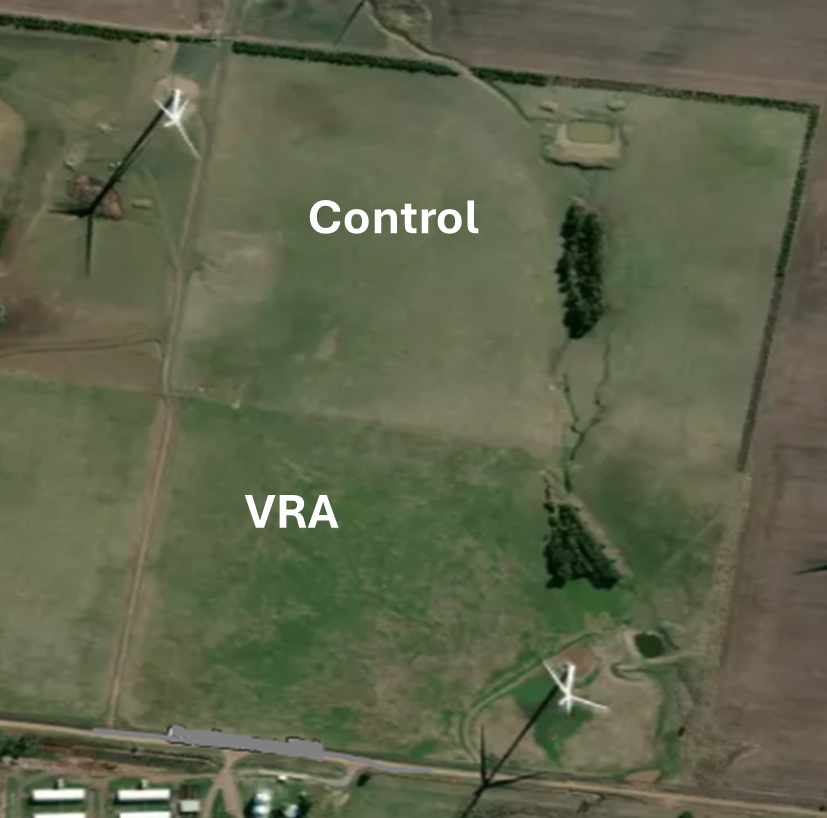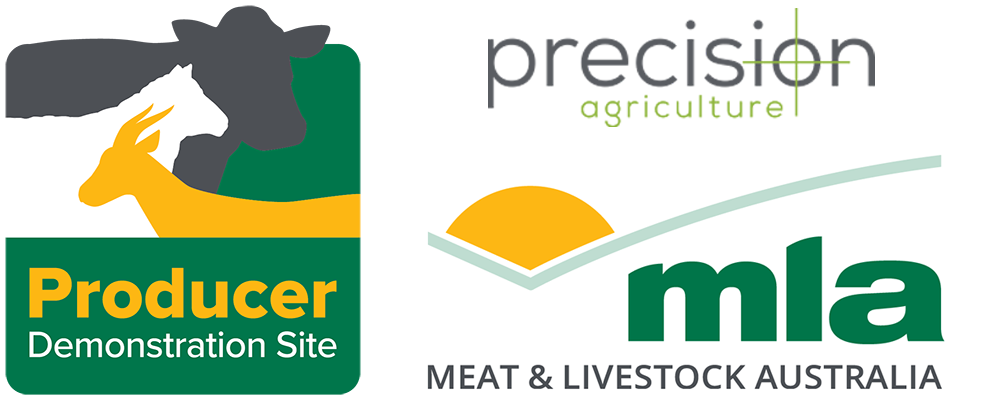Producer case study: Graeme and Heather Fagg
Graeme and Heather Fagg, together with daughter Annie-May and son Tom, manage a 4,000-head, 18.5-micron merino flock and 2,000 crossbred prime lambs at Mt Mercer, near Ballarat, Victoria.
The Faggs were one of 4 host farmers from the Pyrenees and Smeaton BestWool/BestLamb groups to take part in the ‘Precision Soil Mapping in Central Victorian Pastures’ Producer Demonstration Site (PDS) project. The project investigated the potential of grid sampling soil to assess nutrient variability to tailor variable-rate application (VRA) of fertiliser and ameliorants to grazing systems.
Graeme and Heather were eager to see whether grid sampling and VRA could improve pasture production and whether the costs involved were offset by the benefits.

Soil characteristics and nutrient levels across grazing paddocks can be highly variable. Factors such as the underlying variation in soil type, previous management, water movement, stock camps and uneven return of dung and urine across a paddock result in substantial variability in soil nutrient status.
Grid soil mapping provides a method of testing a paddock for variability in pH and nutrient levels. It is currently the most accurate method for developing VRA, which uses variable-rate technology to match fertiliser rates to pasture requirements across an entire paddock. This approach is widely used in the cropping industry but has seen limited uptake in grazing systems in central Victoria.
The site
The Faggs’ property is gently undulating with clay loam soil. Their long-term average rainfall is approximately 600 mm, and they work on a 12 dry sheep equivalent (DSE)/ha carrying capacity.
The Faggs’ demonstration site used VRA technology for the application of lime and gypsum to an older pasture. The control was a phalaris/clover pasture and the VRA was phalaris/perennial ryegrass/clover, all with similar proportions of perennial grass and clover.
Historically, the Faggs undertook soil sampling of some paddocks and applied about 100 kg of single superphosphate (SSP)/year across the farm, with lime applied ahead of pasture renovations, as the budget allowed. Pasture renovation for the Fagg family generally involves a fodder crop (turnips), followed by two years of cereals, before planting a perennial pasture (Figure 2).

Method
Grid-based soil sampling was used to assess variability in soil nutrients across representative grazing paddocks at each of the 4 host farms involved in the PDS. All paddocks were grid soil sampled at 0–10 cm depth at a 1 ha resolution (as per commercial standard practice) in December 2020.
Soil samples were tested for pH, Olsen phosphorus (P), sulfur (S) and exchangeable cations (potassium [K], magnesium [Mg], sodium [Na], calcium [Ca]) at an accredited soil laboratory. Subsoil samples were also collected at lower resolution (approximately every 10th grid square, targeted based on initial results) in 0–5cm, 5–10 cm, 10–15 cm and 15–20 cm increments to identify any pH stratification issues.
A producer steering committee developed paddock targets to address limitations to pasture production. Paired-paddock demonstrations were established to compare VRA versus the control, which involved conventional blanket applications of key inputs (phosphor, potassium, lime or gypsum). Rates for the conventional applications were determined by the steering committee (using industry ‘rules of thumb’), based on a single set of soil test results (the paddock average from grid sample points) to achieve the target level.
Similar management was used across the paired paddocks, including similar grazing strategies.
Return soil sampling was undertaken 3 years later (in 2023) to assess any changes in soil conditions.
Pasture composition, feed on offer, stocking rate and pasture quality were monitored throughout the project to assess any impact on livestock and pasture production.
The benefits and costs of using VRA versus conventional blanket (control) applications when applying key pasture inputs were assessed by comparing the costs and relative pasture production (benefits) of the 2 systems.
Soil targets for the Faggs’ site included increasing pH to 5.5 and reducing exchangeable sodium percentage (ESP) to less than 6%. The paddock treatments included:
- Lime: the control paddock received the district ‘rule of thumb’ of 2.5 t/ha. The VRA paddock received a variable application calculated to increase pH to 5.5, which equated to an average of 2.4 t/ha.
- Gypsum: the control paddock received district ‘rule of thumb’ of 2.5 t/ha. The VRA paddock received a calculated rate to reduce ESP to less than 6%, assuming a 60% efficiency in the displacement of sodium from the soil. This averaged 0.6 t/ha across the paddock.
Results
Soil test results
Lime
The control paddock started with an average pH of 4.6 in 2020 (range 4.6–4.8), which increased to 5.1 in 2023 (range 5.0–5.3) after receiving 2.5 t/ha. The VRA paddock increased in pH from an average of 4.8 in 2020 (range 4.6–5.0) to 5.2 in 2023 (range 4.9–5.3) after receiving an average 2.4 t/ha.
Both paddocks fell short of the pH 5.5 target and there was little change in the variability in soil pH due to the low variability in the initial sampling.
Gypsum
Both the control and VRA gypsum applications reduced the ESP across the paddock to less than 6% (Figure 3). The control started with an average ESP of 7.5% (range 3.9–12.3%), which was reduced to 4.1% (range 2.5–5.5%) through application of 2.5t/ha. The VRA started with an average of 7.0% (range 5.6–11.3), which reduced to an average of 5.1% (range 3.8–6.1%) through the average application of 0.6 t/ha.
Pasture response/production
No consistent difference was measured in pasture production, stocking rate, pasture quality or pasture paddocks throughout the demonstration.
No additional benefit was measured in the VRA paddock compared to the control paddock.
Economic outcomes
The economic analysis focused on the costs relative to the pasture production in the VRA and control paddocks. The results presented in Table 1 show that there were large differences in the soil sampling cost between the 2 treatments, with the 18 ha VRA paddock equating to $1,350 (compared to a single soil test cost).
Ameliorant costs were higher in the control paddock. This is due to the ‘rule of thumb’ gypsum application of 2.5 t/ha being a higher rate than was required to bring ESP below 6%. By comparison, the VRA paddock had an application rate average of only 0.6 t/ha, incurring a lower application cost. The increased rate of gypsum in the control meant that paddock finished at a lower ESP than was required to hit the target.
The rate and cost of lime was similar between the control (2.5 t/ha) and the VRA (2.4 t/ha).
Table 1: Comparison of 3-year (2021–23) costs and pasture growth of the 2 soil management treatments
Control paddock | VRA paddock | |
|---|---|---|
Total soil sampling cost ($/ha) | $4 | $75 |
Total ameliorate (lime and gypsum) cost ($/ha) | $316 | $162 |
Total maintenance fertiliser cost ($/ha) | $159 | $159 |
Total treatment cost ($/ha) | $480 | $397 |
Total 3-year pasture growth (tDM/ha) | 16.7 | 16.1 |
Total treatment cost ($/tDM) | $29 | $25 |
The savings from reduced ameliorant application on the VRA paddocks were largely offset by the higher sampling cost of VRA. These results demonstrate the benefits and costs of additional information. In part this is a result of the law of diminishing returns to extra inputs. This principle also applies to extra inputs of information to production decisions, as demonstrated by intensive point sampling relative to transect sampling.
Host feedback
Heather and Graeme said they’ve learnt a great deal from hosting the demonstration.
‘It’s not a short-term project – improvements require a program to target the needs of each paddock. Grid soil testing helped us understand our paddocks but it’s important with any soil testing to sit down with someone qualified to go through the results and work out what is needed,’ Graeme said.
‘We found it challenging to find someone to apply variable rate on our smaller grazing paddocks, but we have gone on to trial grid soil testing (2 ha grid size) and VRA for lime and gypsum on our cropping paddocks this year.
‘The BestWool/BestLamb group has been great for drawing out questions and answers on the topic. We are always happy to participate in trials that can improve our place and drive efficiencies.’
Summary
- Grid soil sampling provided detailed soil information and identified high variability in ESP but low variability in pH across this site.
- The VRA and control (blanket) application of lime and gypsum ameliorated soil pH and sodicity but both fell short of the pH target and exceeded the ESP target. However, the benefit in the longer term of exceeding the ESP targets is anticipated to offset the short-term cost.
- Whether using a single soil test or grid mapping, calculating required applications rates or seeking assistance (e.g. from an agronomist) rather than applying ‘rules of thumb’, can help to cost-effectively meet paddock targets. The ‘standard’ application of 2.5 t/ha gypsum in the control was more than required, with the target (less than 6% ESP) being exceeded.
- The demonstration highlighted the importance of resampling paddocks over time to understand trends and impacts of applications (and animal movements within paddocks and across the farm).
- No obvious or consistent differences were measured in pasture production, quality and composition or stocking rates between the control and VRA paddocks.
- 1 ha resolution grid sampling provided an increased level of soil information at an increased cost ($75/ha) compared to the control ($4/ha). However, commercially a 2 ha grid size is undertaken in Central Victoria at $40/ha to reduce costs while still providing meaningful data to make practical VR application decisions.
Note that this site demonstrated VRA for ameliorants (gypsum and lime) only, rather than fertiliser applications. VRA fertiliser applications were made at other sites with different outcomes, impacted by the movement of nutrients into sheep camps.
Acknowledgements

Thank you to the Fagg family (and other site hosts) for allowing the demonstration to be conducted on their property and the Pyrenees and Smeaton BestWool/BestLamb groups for their participation in the project.